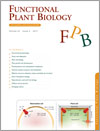
Functional Plant Biology
Volume 44 Number 5 2017
FP16422Why do plants lack sodium pumps and would they benefit from having one?
In contrast to their ancestors, vascular plants do not have a Na+ pump. The lack of a Na+ pump might give a hint as to why vascular plants are so sensitive to salinity. In this minireview, we discuss the feasibility of introducing a Na+ pump to increase the salt tolerance of vascular plants.
FP16280In vivo inhibition of polyamine oxidase by a spermine analogue, MDL-72527, in tomato exposed to sublethal and lethal salt stress
The accumulation of free polyamines (PAs), the terminal oxidation of PAs and the production of H2O2 by diamine oxidases (DAOs) and polyamine oxidases (PAOs), and the expression of selective DAO and PAO genes, depends on the intensity of salt stress in tomato. H2O2 generated by DAO and PAO in cell walls under lethal salt stress induces cell death caused by irreversible loss of electrolytes from tissues. MDL-72527, a PAO inhibitor, impeded PAO-generated H2O2 production and H2O2-induced nitric oxide accumulation but increased electrolyte leakage from tissues, and thus does not increase salt tolerance.
FP16368Effect of FLOWERING LOCUS C on seed germination depends on dormancy
The timing of seed germination and flowering influences the fitness of plants in seasonal environments. Two major flowering-time genes – FLOWERING LOCUS C and FRIGIDA – were shown to influence the propensity of seeds to germinate, both immediately after dispersal and after dormancy breakage and re-induction; these genetic differences in dormancy were manifest as genetic differences in temperature-dependent germination. Therefore, flowering and germination share some genetic basis, potentially coordinating or constraining how plants respond to seasonal cues across their life cycle.
FP16354Consequences of phloem pathway unloading/reloading on equilibrium flows between source and sink: a modelling approach
It is now accepted that there is continuous carbohydrate unloading and reloading along the entire phloem pathway linking sources and sinks. In what way this affects solute concentration and hydrostatic pressure along the pathway is unknown, and at present this is inaccessible to measurement. Hence modelling of this flow is the only route available. In this paper we use a detailed mechanistic model, able to incorporate lateral flows, to determine the effect of phloem pathway unloading/reloading. With adequate reloading, our calculations indicate that this has no overall effect on equilibrium flows, but has a large effect if unloading is not matched by adequate reloading.
FP15381Calcium improves apoplastic–cytosolic ion homeostasis in salt-stressed Vicia faba leaves
This paper describes a new method to measure free Ca concentrations in plants’ extracellular matrix (the apoplast). Extra Ca supply during cultivation increases Ca concentration both in the apoplast and intracellularly, and acidifies the apoplastic pH, which improves ion homeostasis. This may be a further explanation for the favourable effect of Ca for cell expansion and plant growth under salinity.
FP16262Overgrowth (Della) mutants of wheat: development, growth and yield of intragenic suppressors of the Rht-B1c dwarfing gene
The increased wheat yields that occurred during the Green Revolution were made possible by incorporating semidwarfing alleles of the wheat Della gene into new wheat varieties. These alleles are still in widespread use in current wheat varieties, but we have now isolated many new mutants of this gene and characterised their effects on growth, grain dormancy and yield. The results provide insight into regulation of growth by the DELLA protein and indicate particular alleles of potential value in wheat breeding.
FP16294Genotypic water-deficit stress responses in durum wheat: association between physiological traits, microRNA regulatory modules and yield components
Pre-anthesis water-deficit stress causes detrimental effects on the production of crops such as durum wheat in rain-fed areas. In stress tolerant varieties, the regulation of microRNA160 and the mRNA that it targets, auxin response factors, are potentially associated with the unaffected leaf relative water content and chlorophyll content, and the co-ordinated control of stomatal aperture, which ultimately contribute to the maintenance of grain number and yield. Together, these findings suggest the importance of durum microRNA regulatory modules in water stress responses and provide useful information for improving stress tolerance in breeding.
FP16398Plants in constrained canopy micro-swards compensate for decreased root biomass and soil exploration with increased amounts of rhizosphere carboxylates
Annual pasture legumes with a superior ability to acquire soil phosphorus (P) through specialised root systems could lower P-fertiliser requirements. Root traits related to P-acquisition are commonly examined for plants in pots grown in glasshouses; however, root length was greatly decreased and root exudates greatly increased when shoots of these plants were constrained from spreading laterally, as would also occur in dense pasture swards in the field. We suggest that canopy constraint should be routinely used when screening plants in the glasshouse for root traits likely to improve P-acquisition under field conditions.



